back to the list of in-depth studies
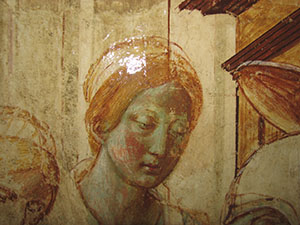
Film of organic substance attributable to a polishing treatment applied to the Tabernacle of the Visitation frescos.
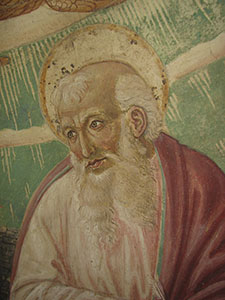
Small, dark, roundish marks on the frescos of the Tabernacle of the Visitation.
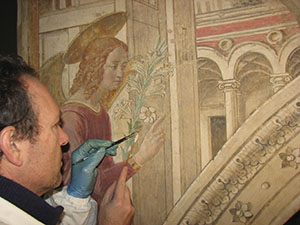
Final cleaning of the frescos with cotton balls soaked in demineralised water.
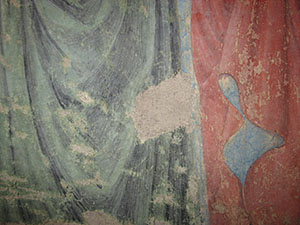
Final stage of restoration of the painted images with watercolours, using the chromatic selection method in the gaps and tone-lowering in all areas damaged by abrasion or vandalism or where the painted surface had simply been lost.
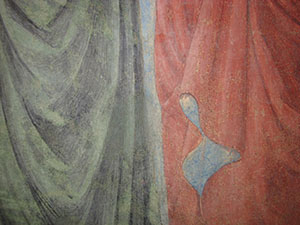
Final stage of restoration of the painted images with watercolours, using the chromatic selection method in the gaps and tone-lowering in all areas damaged by abrasion or vandalism or where the painted surface had simply been lost.
The Tabernacle of the Visitation, on the ancient Volterra road (now Via Benozzo Gozzoli), opposite the road leading to the Convent of Santa Maria della Marca (Saint Mary of the Marca), was frescoed in 1491 by Benozzo Gozzoli.
Later on, "at a time long after its construction, and when the frescoes had suffered the ravages of time and perhaps damage by travellers, a square loggia was erected around it, supported by pillars at the corners and columns at the sides. This loggia was later enclosed by walls with the addition of an altar".
The frescoes underwent subsequent restoration, by the Convent in 1852 and the Italian Ministry of Public Education in 1872, as can still be read today on a plaque affixed to one of the chapel walls.
In 1965, the frescoes and most of the remaining sinopia paintings (the whole of the lower and part of the upper register having been lost) were removed by the Tintori, Rosi and Del Serra studio by applying two cloths - one calico and one hemp - with hot animal glue.
The new backing for the painted surface was made from two calico cloths with a vinyl-based adhesive and calcium carbonate. When completely dry, the cloth backing used to detach the painted surface was removed using steam and hot water. The frescoes were then applied to a hardened Masonite panel in three 1.5 cm-thick layers.
Between 1968 and 1979, the aedicule and some of the recovered sinopia paintings were used, together with other detached frescoes, in a touring exhibition - curated by Ugo Procacci, Umberto Baldini, Luciano Berti, Paolo dal Poggetto, Alfio del Serra, Dino Dini, Giuseppe Rosi and Leonetto Tintori - in the cities of Florence (1968), New York (1968), Amsterdam (1968-1969), London (1969), Monaco (1969), Brussels (1969), Lugano (1970), Stockholm (1970), Copenhagen (1970), Paris (1970), Milan (1971) and Mexico City (1979).
In 1986, they were returned to Castelfiorentino and displayed in several rooms in the library, with the architecture of the tabernacle divided into three sections in order to fit the height of the venues.
Today, the tabernacle has been transferred to the new, especially designed museum, completely restored to its original architectural form (the height measured at the sides nearest the lower parts of the eaves of 5.6 m, as per the original dimensions, while the height measured at the top of the eaves is 6.20 m, lower by 0.28 m than the original size).
Before their most recent restoration, the frescoes were obscured by a layer of dust and a yellow glaze which, when chemically analysed, was found to be a film of organic substance attributable to a polishing treatment.
All the gildings have been almost entirely lost over time, as have the parts painted "dry", leaving the preparatory drawings visible.
The frescoes were also marked by small, dark, roundish blotches, although specific microbiological analysis has excluded the presence of organisms such as bacteria or mould.
There were numerous signs of mechanical alterations (such as holes for screws, accidental scratches, abrasions, etc.), due to the many movements the works have undergone.
The restoration work was carried out in stages.
The first of these involved removing the solid particles and dust deposits using soft bristle brushes, followed by gentle cleaning with Wischab sponges.
The small areas of raised colour were consolidated through microinjections of acrylic resin (Acril 33/a) in aqueous solution, and some detachments from the backing were consolidated using aqueous solution charged with micronised calcium carbonate.
Since the behaviour of the original materials, and particularly the detached wall paintings, was not always homogenous, it was deemed preferable to proceed little by little, checking the differing levels of cleaning achieved.
The small, dark, roundish blotches were removed using the following technique: application of Japanese paper and demineralised water containing 1.5% tributyltin oxide (biotin N), for a contact time of 4 minutes. After seven days, the operation was repeated using Japanese paper and 12-volume hydrogen peroxide containing 1.5% tributyltin oxide (biotin N).
The small, dark blotches were then removed mechanically using a scalpel and cotton balls soaked in 8% ammonium carbonate solution.
Final cleaning was performed by applying Japanese paper soaked in an aqueous solution of 3% ammonium bicarbonate for a contact time of 4 minutes, after which the painted surface was cleaned using cotton balls soaked in demineralised water.
The screws and panel sections were filled in using an acrylic-based mortar charged with inert substances (sand, pumice, tuff and calcium carbonate), of various grains and pigmentations.
Finally, the frescoes were treated with a multi-purpose biocide (Biotin N diluted to 1.5% in water) to protect them from future attacks by biological agents.
The last stage involved restoration of the painted images using watercolour paints. In order to achieve a critical restoration of the pictorial text, the chromatic selection method was used to fill in the gaps and missing parts, with tone-lowering in all the areas of abrasion, damage or loss of the painted layer.
Sinopia paintings
Restoration of the sinopia paintings began with removal of the solid particles and dust deposits using soft bristle brushes, followed by gentle cleaning with Wischab sponges.
Final cleaning was performed by applying Japanese paper soaked in an aqueous solution of 3% ammonium bicarbonate for a contact time of 4 minutes, after which the painted surface was cleaned using small natural sponges soaked in demineralised water.
Finally, they were treated with a multi-purpose biocide (Biotin N diluted to 1.5% in water) to protect them from future attacks by biological agents.
The few filling operations were carried out using an acrylic-based mortar charged with inert substances (sand, pumice, tuff and calcium carbonate), of various grains and pigmentations.
Restoration of the painted images using watercolour paints consisted solely of restoring the chromatic unity of the work with thin coats.
Fabrizio Iacopini